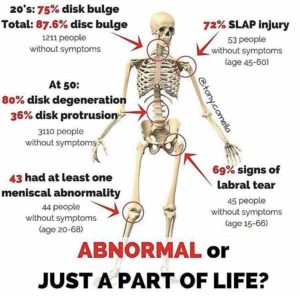By Mitch Hauschildt, MA, ATC, CSCS
I recently saw this post on Instagram from Dr Erson Religioso III, DPT, MS (@modernmanualtherapy), and it really resonated with me. By the way, if you aren’t following him, you should be.
The graphic really drives home the idea that tissue damage is not correlated with pain. It cites multiple studies that show a large majority of our population have structural damage throughout their body, but are still pain free. I have seen similar studies in the past, but this graphic does a great job of putting things together into one area to really drive home the point. So, what do we make of this?
What generates pain?
First and foremost, pain is not correlated with tissue damage. I know I just said that, but it is worth repeating because too many clinicians are stuck on structure. Structural issues can lead to a threat at the brain, but that perceived threat is what is causing the pain, not the tissue itself. This is important to understand, because it means that when we neurologically tweak the system, we can down regulate pain without changing structure, which can lead to really good outcomes for many of our patients and clients. This can also be an effective strategy for helping people through an event, such as an important race or tournament after they have sustained an injury. We do this all of the time at the collegiate level with our athletes to make sure that they can compete at a high level.
Pain is an output and it is generated in the brain. The better we can grasp that concept, the better off our patients will be.
What about diagnostic testing?
What this tells me is that we should be very wary of MRIs and other diagnostic tests. Despite popular opinion among the general population, MRIs are not the magic answer for all of our issues. The more I practice, the more I question what MRIs actually tell us. Yes, they do show us structural problems, but those structural problems may or may not be causing their pain. Testing results MUST be correlated with a clinical exam, a mechanism of injury, and should just be considered just a piece of the overall diagnostic puzzle.
I can’t tell you how many times I have seen people with mechanical low back pain that have had an MRI that has shown something that leads them down the road of injections or surgery that don’t ever help because the MRI findings are just a coincidence and don’t have anything to do with the injury.
Is this normal?
This is an interesting question. It depends on your definition of “normal.” Are these things just a part of normal life? My answer to this question is that all of these things are likely normal, but not optimal. Normal isn’t always good (even though human nature tells us that we want to fit in).
I think the term “natural” is very similar. Having “all natural” things in our lives is a buzz word in today’s world and it is assumed to be a good thing. But, there are lots of “natural” things that aren’t healthy. For example, mercury is a naturally occurring element in our world. But, I certainly don’t want to consume it. So is lead, and chlorine, and so on. Just because something is “natural” doesn’t make it good.
Tissue damage may be “normal” in our society, but that doesn’t make it a good thing. One challenge that we fact in our comfortable, western society is that we (hopefully) balance inactivity with activity. We tend to sit all day, gaining weight and shutting down our stabilizers. Then, we go as hard as we can, working out in the latest fitness fad at the gym, or playing pick up basketball with our friends. All of this sets us up for tissue damage.
It has also been said that “either I harm my joints by exercising or my heart by not doing anything.” I do think that is true to a certain degree, so I tend to see chronic changes in joint surfaces as a bit of a sign of an active life well lived. That is obviously within reason and we should hope that if we are working well biomechanically that these issues can be minimized.
So, I guess my answer to whether or not it is “normal” or not is, yes it is common and fairly normal in our society, but it isn’t optimal.
Take Home
Simply put…tissue damage occurs in most people at high rate, but oftentimes isn’t correlated with pain. Be careful interpreting diagnostic testing and things might be “normal”, but that doesn’t mean that they are good or bad.
Use your very bright brain that the good Lord gave you to think through your patient’s injuries and dysfunction and don’t be afraid to reject things taken at face value to dig deeper into what else is contributing to their main complaint.


Well put my friend! Just had a client cancel his appointment because the Dr. Gave him note saying he can’t receive a massage due to a building disc. I said that’s absurd half the population has a disk bulge that goes undiagnosed.
I have been dealing or trying to deal with this for years but your wording is a whole lot better than mine and perhaps will be more affective. Thanks for sharing.
Nice one! Great article, Mitch!
Makes good sense. What is common and what is normal are usually two different things. I believe that active people will see more injuries in their lifetime and it would be ‘normal’ to see more injuries as you use your body more but that does not mean you are in constant pain. Life is too boring sitting in an armchair all your life-no thanks.